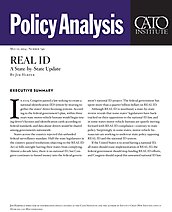States across the country rejected this unfunded federal surveillance mandate. Half the state legislatures in the country passed resolutions objecting to the REAL ID Act or bills outright barring their states from complying. Almost a decade later, there is no national ID, but Congress continues to funnel money into the federal government’s national ID project. The federal government has spent more than a quarter billion dollars on REAL ID.
Although REAL ID is moribund, a state-by-state review reveals that some states’ legislatures have backtracked on their opposition to the national ID law, and in some states motor vehicle bureaus are quietly moving forward with REAL ID compliance—contrary to state policy. Surprisingly, in some states, motor vehicle bureaucrats are working to undercut state policy opposing REAL ID and the national ID system.
If the United States is to avoid having a national ID, all states should cease implementation of REAL ID, the federal government should stop funding REAL ID efforts, and Congress should repeal this unwanted national ID law.


